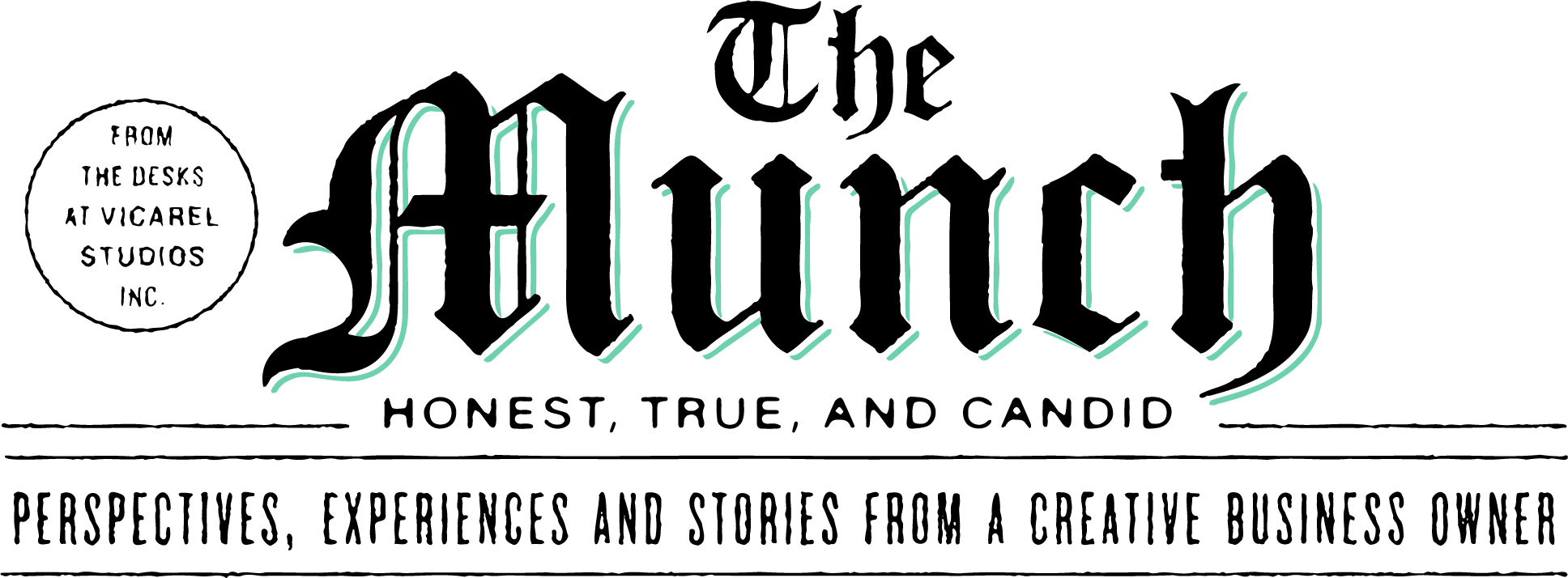Graphic design portfolio recommendations that you must consider
Vol. 093
Graphic design portfolio recommendations that you must consider
Whether you’re a seasoned designer or new to the industry, don’t forget these 5 things when you create your graphic design portfolio website.
Over the years I've reviewed 100’s of graphic design portfolios.
Some of these reviews were to provide feedback for young designers, but many were in the context of me wanting to hire freelancers for Vicarel Studios.
Ultimately, I’ve left countless websites and decided not to work with a lot of freelancers because they made it too difficult for me to find or understand the information that I wanted or needed.
If you’re looking for graphic portfolio tips for job applications or for getting hired as a freelancer, be sure to read through the end — the details of the last one might surprise you!
In no particular order, these are the top five things freelance graphic designers and creative entrepreneurs should have on their website to get hired by agencies.
Your services. Make it painfully clear what you do.
A photo of you. Humanize your digital experience.
Your work (that you WANT to do). Don’t make them guess.
Your experience. Prove you’re worth it.
Your email address. Not just a contact form.
**You’re going to want to read on, because some of these aren’t as obvious as you might think!
1) List your services first, and your Bio second.
Write a 1-3 sentences that capture your offering. Tell people what you do. Or, more importantly, what you want to be hired to do.
Then, if you care to, go into further detail your personal story, inspiration or past experience.
I’ve seen so many websites that have a 4 paragraph story about an individuals life story, and never once does it mention what they really want to be doing (logo design and packaging, for example.) This is a big no no.
You only have seconds to capture people's attention. Make it clear. Make it obvious. And make it easy.
2) Have a photo of you on your website:
Have a photo of yourself on your about or contact page. Simple as that.
Personalization is key. We going through various freelance graphic design portfolios, I want to feel like I know who I'm potentially hiring before I reach out to them. That human connection felt through a photo goes a long way.
In fact, this Harvard article suggests that an emotional connection matters more than customer satisfaction. i.e., a potential employer feeling connected to who you are could be more important than the work shown in your portfolio!
Don’t overcomplicate this. Your photo doesn’t need to be a professional headshot or anything fancy. In fact, it doesn’t even need to be your face.
The photo should be authentic to who you are — you can be goofy, or serious, a work in progress, an image of your work, you as a toddler, or you climbing a mountain — whatever! Just put something that captures your personality and fosters human connection.
3) Your portfolio should display the work that you WANT to be doing (not just the work that you’ve done)
How do you make a good graphic design portfolio? You focus on showing the work that you want to be hired to do. This may seem obvious, but I see this is one of the biggest mistakes that graphic designers make in their portfolios.
Yes, if you want to get hired for "everything you can do" then go ahead and show that at in your portfolio: you can show your graphic design work, jewelry art, murals, pottery, photography, web design, print design, logos, and those fliers for the local law firm you hated creating.
However, if you just want to be doing logo design and illustration, you shouldn't really be showing much other than that.
If you feel all of those “other things” that you do are relevant to your brand or story, and you can’t bring yourself to remove them from yourwebsite put it on a separate website or embed it deeper into the website.
Don’t muddy the waters — pick a couple/few services or offerings that you want to be focusing on, and put those in your portfolio.
If you haven’t been hired for the work that you want to be creating, consider creating a few personal projects and building out a case study.
Think of it like this: if you don't tell people what to hire you for, they’ll hire you for what they think you should do. Do you really want Karen to dictate your business offerings? 😂
How many pieces should be in a graphic design portfolio?
Generally speaking, less is more. 2-3 great case studies that thoroughly capture the project opportunity, the solution, and the process is far better than 5-10+ portfolio pieces that hardly show or explain any design thinking.
As always, consider who your audience is (Hiring managers? Creative directors? Agency owners? Other designers?) and cater your content to them. A graphic designer will likely display and present their work differently than an illustrator or art director.
4) Show your experience
You can capture this through client testimonials or through listing some of the prominent brands you've worked on. Highlighting your credibility is important so that you can build trust with individuals before they even work with you.
5) Put your email address on your website (not just a contact form)
You need to have your email address on your website, not just a contact form.
Contact forms often only allow for text submissions. Numerous times I've been on a website and I’ve wanted to email a brief, an image, or something other than just copy, but the individual's contact form didn’t allow for such submissions.
In these cases, I often just leave leave the website and move onto the next. I don't end up working with these people because they make it too difficult to even start the conversation.
Your website should make it as easy as possible for people to get a hold of you.
Put your email address somewhere easy to find on your damn website.
If you embrace these 5 points when building or updating your graphic design portfolio you’ll be far more likely to connect with potential clients and hirers, you’ll be better at conveying your unique skillset and value, and you’ll be much easier to get a hold of.
Cheers,
Adam

